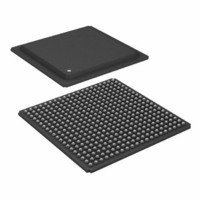ADSP-21160NCB-100 Analog Devices Inc, ADSP-21160NCB-100 Datasheet - Page 5

ADSP-21160NCB-100
Manufacturer Part Number
ADSP-21160NCB-100
Description
IC,DSP,32-BIT,CMOS,BGA,400PIN,PLASTIC
Manufacturer
Analog Devices Inc
Series
SHARC®r
Type
Floating Pointr
Specifications of ADSP-21160NCB-100
Rohs Status
RoHS non-compliant
Interface
Host Interface, Link Port, Serial Port
Clock Rate
100MHz
Non-volatile Memory
External
On-chip Ram
512kB
Voltage - I/o
3.30V
Voltage - Core
1.90V
Operating Temperature
-40°C ~ 100°C
Mounting Type
Surface Mount
Package / Case
400-BGA
Package
400BGA
Numeric And Arithmetic Format
Floating-Point
Maximum Speed
100 MHz
Ram Size
512 KB
Device Million Instructions Per Second
100 MIPS
Lead Free Status / RoHS Status
Available stocks
Company
Part Number
Manufacturer
Quantity
Price
Company:
Part Number:
ADSP-21160NCB-100
Manufacturer:
Analog Devices Inc
Quantity:
10 000
enabled, the same instruction is executed in both processing ele-
ments, but each processing element operates on different data.
This architecture is efficient at executing math-intensive DSP
algorithms.
Entering SIMD mode also has an effect on the way data is trans-
ferred between memory and the processing elements. In SIMD
mode, twice the data bandwidth is required to sustain computa-
tional operation in the processing elements. Because of this
requirement, entering SIMD mode also doubles the bandwidth
between memory and the processing elements. When using the
DAGs to transfer data in SIMD mode, two data values are trans-
ferred with each access of memory or the register file.
Independent, Parallel Computation Units
Within each processing element is a set of computational units.
The computational units consist of an arithmetic/logic unit
(ALU), multiplier, and shifter. These units perform single-cycle
instructions. The three units within each processing element are
arranged in parallel, maximizing computational throughput.
Single multifunction instructions execute parallel ALU and
multiplier operations. In SIMD mode, the parallel ALU and
multiplier operations occur in both processing elements. These
computation units support IEEE 32-bit single-precision float-
ing-point, 40-bit extended-precision floating-point, and 32-bit
fixed-point data formats.
(OPTIONAL)
(OPTIONAL)
(OPTIONAL)
DEVICES
DEVICE
(6 MAX)
SERIAL
SERIAL
DEVICE
CLOCK
LINK
4
3
4
CLKIN
EBOOT
LBOOT
IRQ2–0
FLAG3–0
TIMEXP
LXCLK
LXACK
LXDAT7–0
TCLK0
RCLK0
TFS0
RSF0
DT0
DR0
TCLK1
RCLK1
TFS1
RSF1
DT1
DR1
RPBA
ID2–0
CLK_CFG3–0
Figure 2. Single-Processor System
ADSP-21160X
RESET
ADDR31–0
DATA63–0
DMAG1–2
DMAR1–2
CLKOUT
JTAG
MS3–0
BR1–6
PAGE
REDY
BRST
SBTS
BMS
WRx
HBG
ACK
HBR
RDx
6
CIF
CS
PA
DATA
ADDR
DATA
ADDR
DATA
CS
ADDR
DATA
OE
WE
ACK
CS
Rev. B | Page 5 of 60 | February 2010
PROCESSOR
INTERFACE
(OPTIONAL)
DMA DEVICE
(OPTIONAL)
(OPTIONAL)
(OPTIONAL)
MEMORY/
HOST
MAPPED
DEVICES
EPROM
BOOT
Data Register File
A general-purpose data register file is contained in each pro-
cessing element. The register files transfer data between the
computation units and the data buses, and store intermediate
results. These 10-port, 32-register (16 primary, 16 secondary)
register files, combined with the ADSP-2116x enhanced
Harvard architecture, allow unconstrained data flow between
computation units and internal memory. The registers in PEX
are referred to as R0–R15 and in PEY as S0–S15.
Single-Cycle Fetch of Instruction and Four Operands
The processor features an enhanced Harvard architecture in
which the data memory (DM) bus transfers data, and the pro-
gram memory (PM) bus transfers both instructions and data
(see the functional block diagram 1). With the ADSP-21160x
DSP’s separate program and data memory buses and on-chip
instruction cache, the processor can simultaneously fetch four
operands and an instruction (from the cache), all in a single
cycle.
Instruction Cache
The ADSP-21160x includes an on-chip instruction cache that
enables three-bus operation for fetching an instruction and four
data values. The cache is selective—only the instructions whose
fetches conflict with PM bus data accesses are cached. This
cache allows full-speed execution of core, providing looped
operations, such as digital filter multiply- accumulates and FFT
butterfly processing.
Data Address Generators with Hardware Circular Buffers
The ADSP-21160x DSP’s two data address generators (DAGs)
are used for indirect addressing and provide for implementing
circular data buffers in hardware. Circular buffers allow efficient
programming of delay lines and other data structures required
in digital signal processing, and are commonly used in digital
filters and Fourier transforms. The two DAGs of the product
contain sufficient registers to allow the creation of up to 32 cir-
cular buffers (16 primary register sets, 16 secondary). The DAGs
automatically handle address pointer wraparound, reducing
overhead, increasing performance, and simplifying implemen-
tation. Circular buffers can start and end at any memory
location.
Flexible Instruction Set
The 48-bit instruction word accommodates a variety of parallel
operations for concise programming. For example, the proces-
sor can conditionally execute a multiply, an add, and subtract,
in both processing elements, while branching, all in a single
instruction.
MEMORY AND I/O INTERFACE FEATURES
Augmenting the ADSP-2116x family core, the ADSP-21160x
adds the following architectural features.
ADSP-21160M/ADSP-21160N













